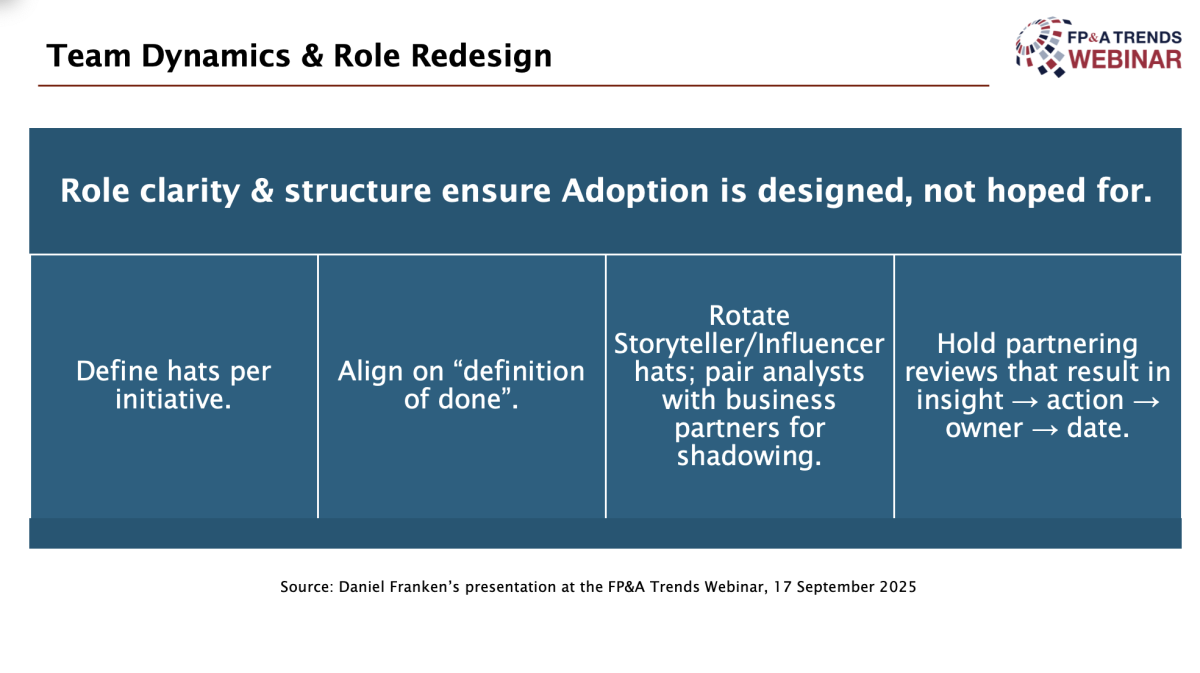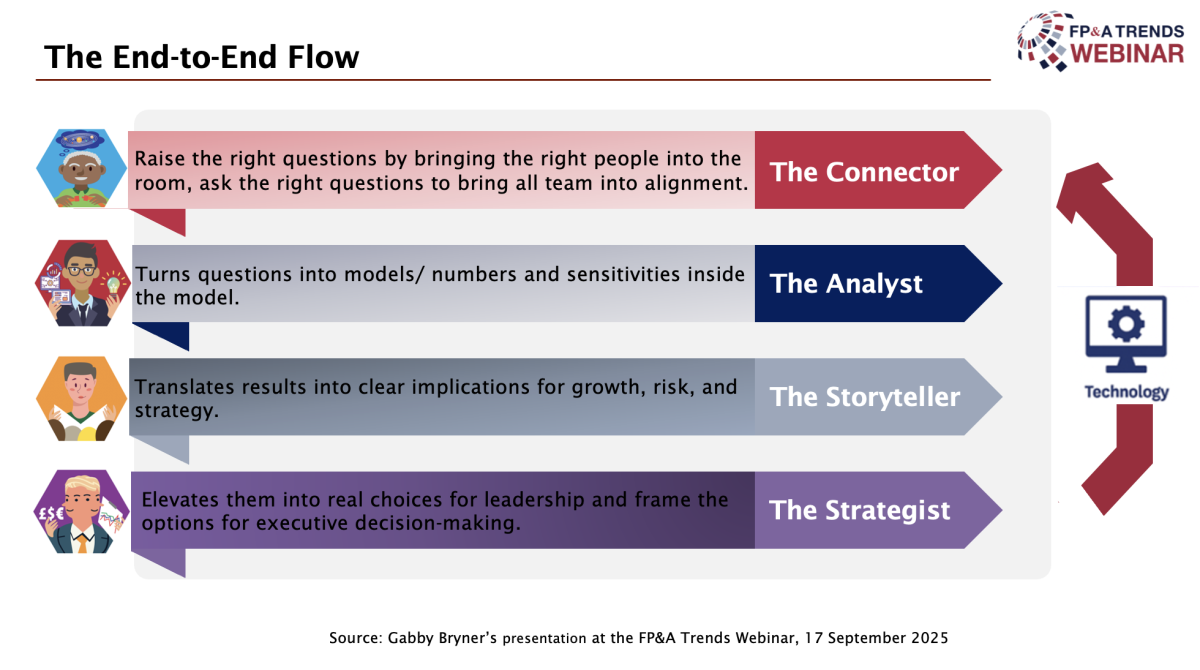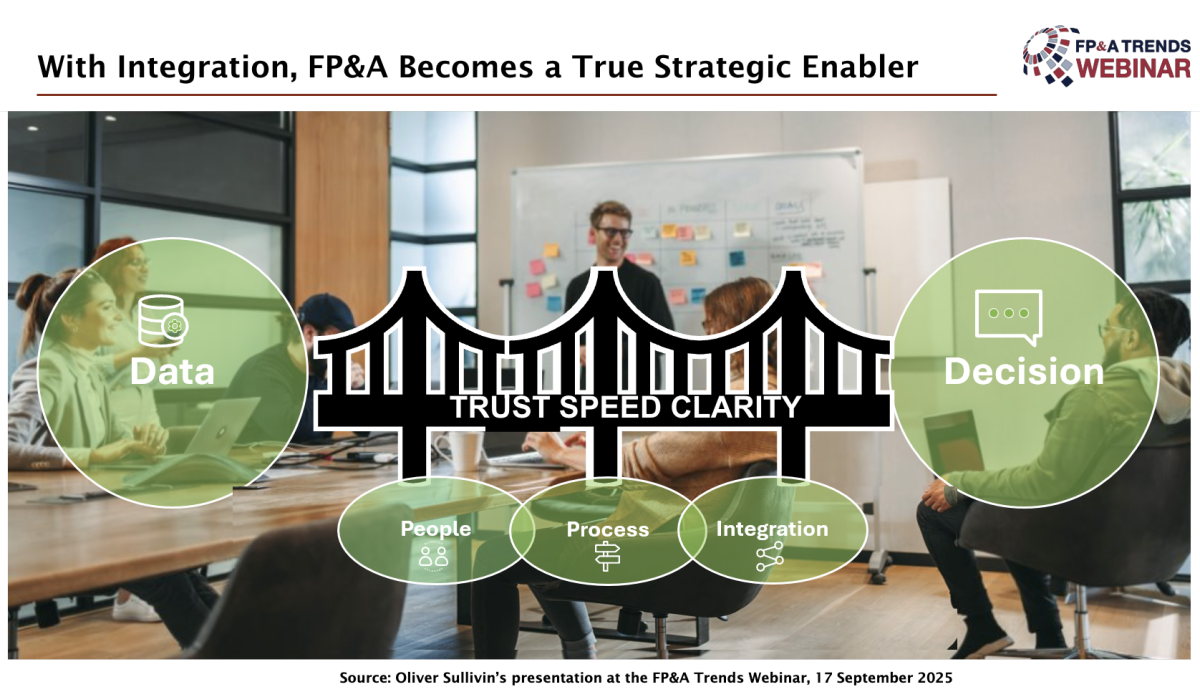In this article, a senior finance leader explores how FP&A teams can unlock true strategic business...
Today, high-performing FP&A teams don’t just report the numbers; they shape the decisions. Yet as finance evolves from transactional to strategic, organisations are asking a critical question: what combination of roles truly drives impact?
This was the focus of the FP&A Trends webinar, “Five Roles Every High-Performing FP&A Team Needs,” held on 17 September 2025.
The session gathered finance leaders from Trouw Nutrition, Dyno Nobel, and Unit4 to share how these roles are applied in practice: from managing crises to scaling decision-making through technology.
The conversation explored how FP&A professionals can become proactive business partners by wearing multiple hats: Analyst, Architect, Data Scientist, Storyteller, and Influencer.
This report highlights the practical insights, frameworks, and lessons shared during the session, offering a blueprint for designing FP&A teams that are agile, tech-enabled, and decision-focused.
The Five Roles in Practice
Daniel Franken, Finance Director & Managing Director Germany, Trouw Nutrition, opened the session by sharing how the five FP&A roles are applied in real-world settings at Trouw Nutrition. Drawing from his experience in global matrix organisations, he emphasised that these roles: Analyst, Architect, Data Scientist, Storyteller, and Influencer, are not static job descriptions but interchangeable “hats” that team members wear depending on the context.
He explained that the team began by mapping their current role coverage to identify strengths and gaps. This helped clarify which roles were well-established and where support was needed. Daniel noted that team members often switch between roles in a single project, such as moving from analysis to storytelling and then into influencing mode.
Technology, particularly AI and Automation, is accelerating the ability to expand coverage and speed up delivery. Daniel highlighted the importance of aligning tools to roles, showing how GenAI copilots, for instance, can help fill capability gaps and improve monthly cadence.

Figure 1
He also stressed the need to define “what done looks like” to enable smoother handovers between roles and functions. Ultimately, Daniel sees building role coverage as an ongoing journey that improves alignment, efficiency, and the ability to deliver value across the business.
Poll Insight: Which of the Five FP&A Roles do You See as the Biggest Gap in Your Team Today?
Data Scientist was selected by the largest share of attendees (36%), indicating growing demand for data science capabilities in FP&A. Architect (20%), Storyteller (21%), and Influencer (21%) were closely followed, each highlighting different areas of development. Analyst (2%) was selected by the fewest participants, showing that this core role is well covered in many teams.
Reactive Planning: Critical Roles in a High-Performing FP&A Team
Gabby Bryner, Senior Director of Finance, Dyno Nobel, presented a compelling case study from Dyno Nobel, a global explosives manufacturer, where FP&A played a central role in navigating a sudden tariff impact on raw materials. Her presentation showcased how the five roles work together under pressure, in a highly practical and urgent setting.
The business challenge was clear: leadership needed to understand how the tariff would affect cost, margin, competitiveness, and customer behaviour. The FP&A team stepped in, not just as analysts, but as cross-functional connectors and strategic advisors.
First, the Connector role aligned Procurement, Commercial, Manufacturing, and Marketing around shared assumptions. Then the Analyst built robust models to quantify EBIT and cash flow scenarios. The Storyteller translated complex data into actionable language for non-financial stakeholders, while the Strategist elevated options to the executive level, framing risks, trade-offs, and recommendations.

Figure 2
Gabby detailed the “end-to-end flow” of how these roles interacted: from raising the right questions, through modelling and insights, to presenting strategic options. She also shared the critical business questions FP&A must now anticipate, such as: “How much can we pass to customers?” or “What are the risks of pre-buying or shifting supply?”
Ultimately, this case underscored FP&A’s ability to lead under uncertainty, not just by producing forecasts, but by guiding choices with clarity, speed, and cross-functional alignment.
Poll Insight: How Involved is Your FP&A Team in Strategic Decision-Making?
Poll responses revealed that 45% of participants view their FP&A teams as moderately involved in strategic decision-making, while 30% indicated their teams are primarily focused on operational support.
Only 20% reported being highly involved at the strategic level, and a further 5% said their teams are not involved at all.
These findings suggest that while many FP&A functions are making strides toward greater strategic influence, there is still considerable room to elevate their role in shaping business decisions.
How ERP-FP&A System Integration Enables Smarter, Faster Teams
Oliver Sullivin, Senior Growth Director FP&A, Unit4, focused on the technological foundations that make FP&A teams more agile and impactful, specifically, the integration of ERP and FP&A systems as a strategic enabler.
He opened with a critical insight: data alone isn’t enough. The modern FP&A function needs trust, agility, and accessibility to turn information into action. Without a unified system, teams face inconsistent assumptions, limited scenario capabilities, and delayed decisions.
Oliver mapped each of the five roles to system integration outcomes. The Analyst relies on integration to ensure trusted, current data for proactive insights. The Architect designs the foundations that make this possible. The Data Scientist benefits from end-to-end data connectivity to model scenarios, reduce cycle times, and shift to foresight planning. The Storyteller draws from a single source of truth to communicate clearly. Finally, the Influencer gains confidence and credibility when insights are timely and consistent.
Real-world examples underscored the value. One public sector client reduced budget cycles from two weeks to real-time updates and achieved 18% time savings through streamlined, online processes.

Figure 3
Oliver concluded with a simple yet powerful message: in today’s fast-moving business environment, organisations that embrace integrated, cloud-based FP&A platforms are better equipped to align teams, streamline operations, and maintain a competitive edge.
Conclusion
The future of FP&A lies in balance: between strategy and operations, human skills and technology, flexibility and structure. As this webinar made clear, the most successful teams are those that combine five critical roles: Analyst, Architect, Data Scientist, Storyteller, and Influencer.
Whether responding to a crisis, enabling fast decisions, or redesigning team structures, the speakers illustrated that these roles are not just theoretical; they are practical, flexible, and essential. They create a common language across functions and provide a roadmap for scaling capability, trust, and speed.
For FP&A leaders, the takeaway is clear: the question isn’t whether you need these five roles, it’s how you will build, empower, and evolve them within your team.
To learn more about the Five FP&A Roles and how to implement them in your organisation:
Watch the full webinar recording
Download the 2025 FP&A Roles Insight Paper
We especially thank Unit4, our sponsor, and all the speakers for their insights and leadership on the future of FP&A.
Subscribe to
FP&A Trends Digest

We will regularly update you on the latest trends and developments in FP&A. Take the opportunity to have articles written by finance thought leaders delivered directly to your inbox; watch compelling webinars; connect with like-minded professionals; and become a part of our global community.







